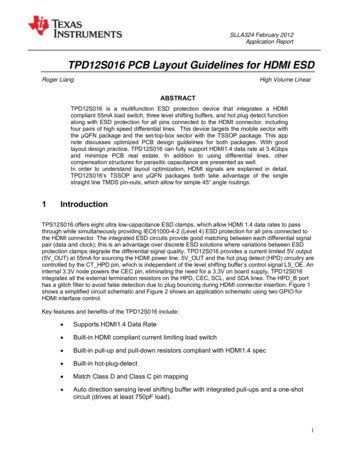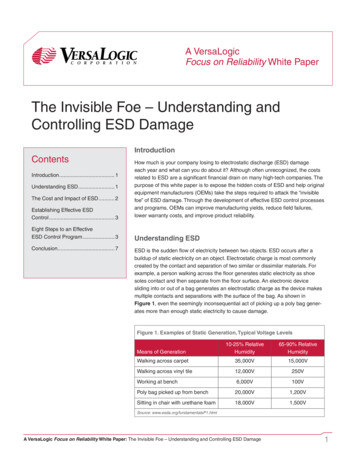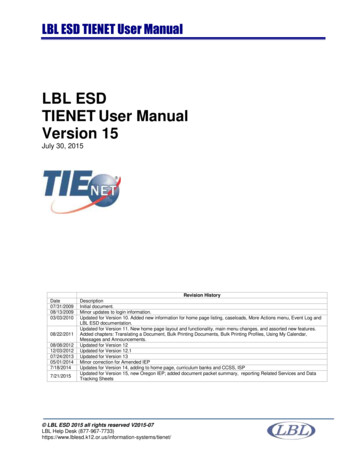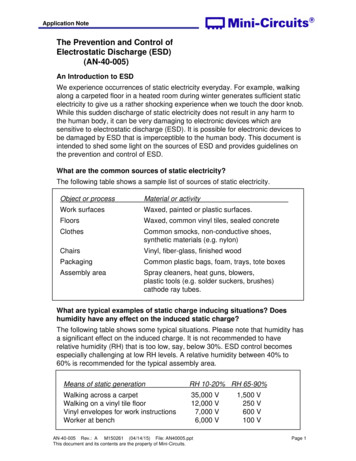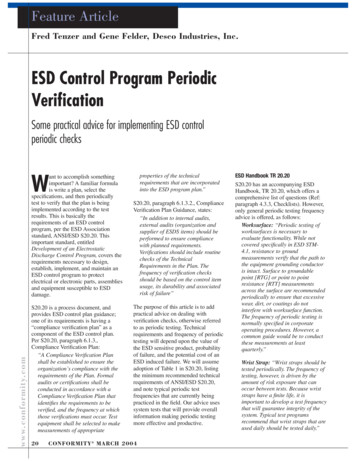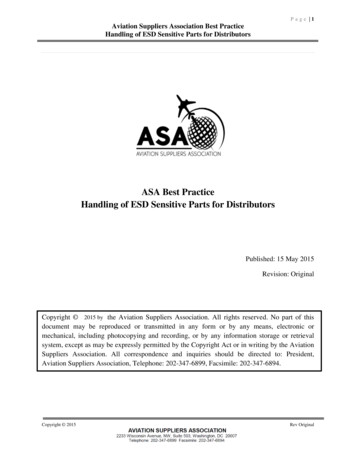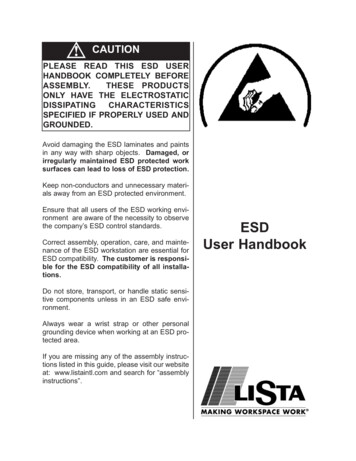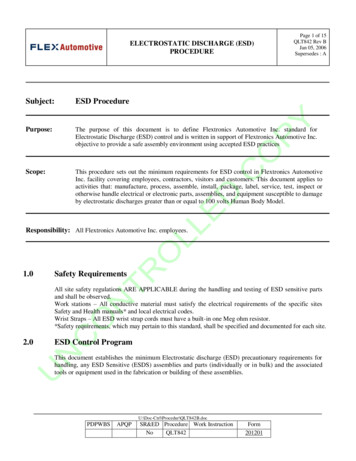
Transcription
ELECTROSTATIC DISCHARGE (ESD)PROCEDUREPage 1 of 15QLT842 Rev BJan 05, 2006Supersedes : ASubject:ESD ProcedurePurpose:The purpose of this document is to define Flextronics Automotive Inc. standard forElectrostatic Discharge (ESD) control and is written in support of Flextronics Automotive Inc.objective to provide a safe assembly environment using accepted ESD practicesScope:This procedure sets out the minimum requirements for ESD control in Flextronics AutomotiveInc. facility covering employees, contractors, visitors and customers. This document applies toactivities that: manufacture, process, assemble, install, package, label, service, test, inspect orotherwise handle electrical or electronic parts, assemblies, and equipment susceptible to damageby electrostatic discharges greater than or equal to 100 volts Human Body Model.Responsibility: All Flextronics Automotive Inc. employees.1.0Safety RequirementsAll site safety regulations ARE APPLICABLE during the handling and testing of ESD sensitive partsand shall be observed.Work stations – All conductive material must satisfy the electrical requirements of the specific sitesSafety and Health manuals* and local electrical codes.Wrist Straps – All ESD wrist strap cords must have a built-in one Meg ohm resistor.*Safety requirements, which may pertain to this standard, shall be specified and documented for each site.2.0ESD Control ProgramThis document establishes the minimum Electrostatic discharge (ESD) precautionary requirements forhandling, any ESD Sensitive (ESDS) assemblies and parts (individually or in bulk) and the associatedtools or equipment used in the fabrication or building of these PQPSR&ED Procedure Work InstructionNoQLT842Form201201
ELECTROSTATIC DISCHARGE (ESD)PROCEDURE2.0.1Page 2 of 15QLT842 Rev BJan 05, 2006Supersedes : AESD Control Program RequirementsLevel of Protection: The intent of this program is to protect all ESDS items, which are sensitive to 100volts or higher Human Body Model. ESD Devices that are more sensitive may require additionalprotection. Customer requirements relating to New Products shall consider levels of protection for allESDS items as applicable. Program Management and Product Engineering are responsible forcommunicating this need to the ESD Coordinator2.0.2ESD Control Program GuidanceThe primary objective of this Program is to provide continuous ESD protection. Electrostatic controland protection entails implementation of Program requirements during design, production, inspection,test, storage, shipment, installation, use, maintenance, replacement, and repair functions.2.1ESD Control Program Administrative Requirements2.1.1ESD Control Program/Policy Guidelines1. Always wear ESD Smocks and Safety Glasses in the manufacturing area.2. Always wear ESD shoes/Shoe strap/Wrist strap on the manufacturing floor as designated3. Daily Verify ESD shoes/Shoe strap/Wrist strap and Sign off against Operation Start up checklist Form #201201 as applicable.4. Always ensure to be grounded when handlings ESDS devices.5. Food, Beverages, Lunch boxes, Personal belongings (Purse, Sweaters/jackets, Combs/brushes,Lotion bottles) strictly prohibited on the manufacturing floor.6. SMT Magazines, Carts, Shelves, Table Mats and Equipments shall be grounded at all times inthe ESD controlled areas.7. SMT Magazines shall not be stored on the floor with or with out WIP PCBs.8. Dragging of Magazines on the floor is strictly prohibited.9. Manufacturing floor and equipments must be kept clean at all time10. Doors in ESD controlled areas shall be kept closed at all time for compliance withHVAC controls.11. Designated boundaries shall be clearly marked for ESD controlled areas.12. Personnel and visitors are required as applicable to use wrist strap, heel straps, or conductiveshoes on the manufacturing floor.13. ESD controlled areas will be measured in regularly scheduled audits by ESD Coordinator.14. All work surfaces shall be grounded and static dissipative in the ESD controlled areas and theirgrounding will be verified against an approved audit15. Replace used ESD pink foam from black trays with new foam every six &ED Procedure Work InstructionNoQLT842Form201201
ELECTROSTATIC DISCHARGE (ESD)PROCEDUREPage 3 of 15QLT842 Rev BJan 05, 2006Supersedes : A2.1.1.1 ESD Control Program MaintenanceTable 1 summarizes the actions (described in previous sections) that should be scheduled and regularlyperformed to maintain an effective ESD control program.FrequencyDailyActionRecords (maintain min 90 days) Check wrist straps, heel straps,and conductive shoes (seesections 2.2.2 A & B)Weekly (or Verify workstation and tableasgrounding (see section 2.2.6 A)determinedby Engr.)Monthly ESD self-audit (see section2.1.3.1) Operation Start up checklist Form #2012015S audit Checklist and writtenverification of correctiveaction(s) Clean and test ionizers Preventive maintenance(PM) log Perform functional check ofwrist/heel strap testers Preventive maintenance logor self-audit checklist/recordSix months Replace used ESD pink foamAction item in shut downfrom black trays with new foam meetingsAnnually Calibrate wrist/footwear tester Maintain records per site(see sections 2.2.6 b & C)calibration procedure Calibrate auditing equipment Maintain records per sitecalibration procedure ESD review training (see section Attendance records2.1.2) Course test results, ifapplicable Audit smocks (see section2.2.2.C) Log of test results andcorrective actions Audit by corporate/sitecoordinator (3rd Party Audits) Checklist and writtenverification of correctiveaction(s)Table 1Site ESD coordinator will be responsible for all ESD related records as outlined in Table 1 or each sitewill be responsible for defining the SAPQPSR&ED Procedure Work InstructionNoQLT842Form201201
ELECTROSTATIC DISCHARGE (ESD)PROCEDURE2.1.2Page 4 of 15QLT842 Rev BJan 05, 2006Supersedes : ATraining PlanAll employees are required to complete ESD training before allowed access to ESD Control Areas. All newemployees are required to complete an ESD orientation before they begin work. It is recommended that allemployees who handle static sensitive parts/assemblies or who work in ESD control areas should receive anESD control review course once a year. If the ESD compliance score fall below 85% as per the FlextronicsAutomotive Inc. audit checklist the site will be required to retrain employees in the affected areas.ESD non-compliances identified during the audits should be the part of the training process. The trainingdepartment or the supervisors will maintain the training record for all employees trained on ESD.The site ESD Coordinator or his designate shall train and verify the competency of those who deliverESD training. Verification of competency shall be undertaken for the following a) Amendments to the corporate training materialb) Where the trainer has not been involved in ESD training for a period of 6 monthsc) Where there are changes in customer ESD requirements2.1.3Compliance Verification PlanAudit activity is to be conducted in accordance with this document and under the general guidance ofthe Site ESD Coordinator.2.1.3.1 Program CoordinationSite ESD Program Coordinator or Quality Manager shall perform audits, and act as a focal point forESD problem resolution.A. Site ESD CoordinatorEach site shall appoint an ESD Program Coordinator who is competent in ESD theory and practice. TheESD coordinator shall be responsible for ESD problem resolution, ESD compliance audits andconsultancy. It is recommended that the Site ESD coordinator audits the system quarterly or ensures thatthe ESD system is included as part of the ISO/QS/TS audits.B. Supervisor ResponsibilitiesSupervisors are responsible for ensuring that operators are issued the appropriate ESD protectiveequipment for their job assignment, and that worn or damaged equipment is promptly replaced.Supervisors are responsible for verifying that all operators are performing the daily ESD wrist and heelstrap tests and for establishing and maintaining Startup check list.Supervisors who leave an area of responsibility should ensure these records are transferred to the newarea PQPSR&ED Procedure Work InstructionNoQLT842Form201201
ELECTROSTATIC DISCHARGE (ESD)PROCEDUREPage 5 of 15QLT842 Rev BJan 05, 2006Supersedes : AC. Area/Building ESD RepresentativeSite ESD coordinator could be one group or person. As a minimum, the following audit schedule will beconducted.One monthly audit of designated area is to be done using the Flextronics Automotive Inc. ESDchecklist; refer to Table 1 for details. Weekly Audits shall consist of a visual inspection of each staticprotected work surface and surrounding area for the requirements as stated in this procedure. Auditresults should be logged along with any resulting corrective actions.The audit will be conducted as per Flextronics Automotive Inc. checklist. The ESD audit checklist is theminimum requirement for the ESD control program where applicable. Scoring will be done as per thefollowing guidelines:Score00.5Compliance LevelNo Plan, Procedure or compliance level is 80%If compliance is between 80% to 90%1N/aIf compliance is 90%Where no site specific requirements applyActionInitiate Formal Corrective ActionRevise Plan, procedure or conductawareness trainingNone-D. 3rd Party AuditsThird party audits shall be conducted on an annual basis. The audit will be done to verify ESDcompliance to Flextronics Automotive Inc. procedure and checklist. The results of the audit will beshared with the Site Operation Manager.2.2ESD Control Program Technical Requirements2.2.1Grounding / Bonding Systems GuidanceGrounding of workstations, carts, storage shelving and personnel is necessary (whereapplicable) to provide a constant and gradual discharge path for static energy so that it is neverallowed to build to levels that can damage electronics.Appropriate methods for grounding include but not limited to:A. 3rd wire AC (Preferred Method)In most cases, the 3 rd wire AC equipment ground is the preferred ESD ground. When this isimpractical or not available to use, personnel should be bonded or electrically connected to aconductive element of the ESD item or container using a wrist strap or other grounding systemto ensure that all elements are at the same electrical potential i.e., a wrist strap may beconnected to a cart or chassis containing ESD items that are being worked on.U:\Doc-Ctrl\Procedur\QLT842B.docPDPWBSAPQPSR&ED Procedure Work InstructionNoQLT842Form201201
ELECTROSTATIC DISCHARGE (ESD)PROCEDUREPage 6 of 15QLT842 Rev BJan 05, 2006Supersedes : AElectrical power ground should be free of hazardous transient voltages, and regularly tested forcontinuity to ground. Caution: Connections to the electrical safety ground should only be madeby person knowledge about the power system being accessed.B. Supporting PillarsSupporting pillars in the buildings campus could be considered grounded. Any rigid, fixed,metallic structure (e.g. copper air tubes) could also be considered ground, provided they areconnected to an unpainted section of a supporting pillar in such a way that the connections arereliable and tamper resistant. The pillars should be connected to the earth and regularly testedfor continuity to ground.C. Copper WireThe reference for ground could be a solid copper stake at least six feet long and 1/2” diameterwhich has been driven into the earth. Brackets should be attached to the top of the stake so thatcables can be securely fixed to the stake (see figure 1). Cables should always be connected tothe nearest, best ground ure 1, Grounding BracketGround reference sources and preferred grounding methods shall be defined and documentedfor each site if necessary.2.2.2 Personal GroundingThe required ESD protection for "ALL" employees is for each to wear an ESD smock togetherwith heel straps/toe straps or ESD footwear (in ESD safe areas). Smocks shall be worn with atleast three of the front snaps closed. Smocks may be worn with sleeves rolled up providing thatthe clothes underneath the smock do not protrude beyond the sleeve line and, in the case ofsmocks which function through surface conductivity; there is a portion of sleeve in contact withthe wearer’s skin. As a general rule, the wearer’s clothes should not be exposed to staticsensitive devices or PQPSR&ED Procedure Work InstructionNoQLT842Form201201
ELECTROSTATIC DISCHARGE (ESD)PROCEDUREPage 7 of 15QLT842 Rev BJan 05, 2006Supersedes : AThe person sponsoring the visitor is responsible for ensuring that they; are provided with allrequired ESD protective equipment when the scope of the visit requires access to ESD sensitiveareas, that the visitor has ESD tested and passed the equipment, and that they comply with thisprocedure while being in a Flextronics Automotive Inc. facility.A. Wrist StrapsA wrist strap is required for anyone handling ESD components or assemblies while seated,regardless of heel grounding. (However, personnel exposed to greater than 500V should beconsidered a special case.) Wrist straps are to be tested at least daily, before handling ESDsensitive items. Putting approved* lotion on the skin contact site and/or adjusting the strap mayhelp it to pass. If the strap still fails it must be replaced. After passing, each operator must signoff startup check list as applicable, which must be current and visible.(*Note: Lotion approved for use in the manufacturing area must be free of silicone and lanolin,and the bottle should be safe for use within an ESD control area, as appropriate. The localEngineering department and ESD coordinator should verify this.)B. Heel StrapsHeel straps, or conductive shoes, may be used to ground personnel in areas where there aregrounded conductive or dissipative floor mats, or where the floor's resistance to groundmeasures between 104 and 109 ohms. The use of heel straps as additional (secondary)grounding devices to help drain static charge generated while walking is encouraged, and maybe required by area management. It is required that the personnel wear one heel strap at alltimes – also if wearing ESD safe shoes the personnel does not necessary have to wear the heelstrap. ESD shoes must have a visible tag or marking on the outside of the shoe to indicate thatthey are ESD shoesConductive heel straps and shoes shall be tested before handling ESD items each day. Heelstraps and shoes that fail the test should be cleaned, adjusted, and retested. If the strap/footwearstill fails it must be replaced. After passing, each person must sign off startup check list ifapplicable, which must be current and visible.C. SmocksSmocks must be worn in all manufacturing areas. They must be audited for effectiveness at leastannually, and replaced as needed. Smocks may be checked for effectiveness in one of twoways: (1) A surface resistivity meter may be used to check that the point to point resistance ofthe fabric is within the dissipative range, (2) A charge is applied to the smock (using a chargedplate analyzer) and then a field meter or static voltmeter is used to verify that the charge isdissipated across the seams. ESD smocks shall, as a minimum, cover all personal garmentsabove the waste in accordance with JEDEC (625-A) requirements.D. Floor MatsGrounded, conductive or dissipative floor mats may be necessary in areas approved forconductive footwear (see section 2.2.2 B). The mats should be cleaned as needed with anapproved antistatic cleaner to prevent the buildup of non-conductive particles on the ED Procedure Work InstructionNoQLT842Form201201
ELECTROSTATIC DISCHARGE (ESD)PROCEDURE2.2.3Page 8 of 15QLT842 Rev BJan 05, 2006Supersedes : AProtected AreaA. SignsSigns should be posted at all entrances to ESD control areas, and the boundaries of these areasshall be clearly identified. The signs should identify the area as an ESD control area anddisplay the JEDEC (Joint Electronic Device Engineering Council) susceptibility symbol.Yellow or fluorescent orange-red is the preferred colors for ESD caution signs and labels.JEDEC susceptibility symbolFigure 2B. FloorThe floor shall be kept clean at all time, magazines should not be on the floor with or withoutPCBs. Dragging the magazines on the floor will damage the floor and it’s resistance to theground. The recommended resistance to ground (RTG) of floors in an ESD control area shouldbe maintained between 104 and 109 ohms (using a 100V test voltage). This condition ismandatory if the floor is used to ground people or carts in the area. Recommended range fornewly installed floors the RTG should be between 104 and 106 ohms.C. EnvironmentWhenever possible, relative humidity in an ESD control area shall be maintained to a minimumof 30%. If the humidity within the production area falls below 30%, the site ESD Coordinatorshall assess if an increased ESD risk. Where this is considered to be likely, the site ESDCoordinator shall implement whatever measures are considered necessary to mitigate theincreased risk. The temperature shall be between 18 C and 27 C (64.4 degree Fahrenheit 80.6degree 842B.docPDPWBSAPQPSR&ED Procedure Work InstructionNoQLT842Form201201
ELECTROSTATIC DISCHARGE (ESD)PROCEDURE2.2.5Page 9 of 15QLT842 Rev BJan 05, 2006Supersedes : AESD protective packaging and package marking shall be in accordance with the contract,purchase order, drawing or other documentation. When the contract, purchase order, drawing orother documentation does not define ESD protective packaging, the Site shall define ESDprotective packaging requirements for ESD items. Some of these types and techniques includelow charge generating bags and wraps, air space, dissipative wrap, static shielding, conductiveshunts and the use of EMI/RFI shielding.Packaging shall be defined for all material movement within Protected Areas, between job sitesand field service operations.MarkingESD assemblies and equipment containing ESD parts and assemblies should be marked with anESD caution symbol as shown in Figure 2.2.2.6EquipmentA. Work Stations and TablesWorkstations and tables in an ESD control area must have static dissipative surfaces and shouldbe connected in parallel. Each workstation must have available wrist strap ground connections(two are recommended), preferably banana jack receptacles. Work surfaces should be cleaneddaily with an antistatic cleaner, and the resistance to ground should be maintained in the staticdissipative range. Surfaces and wrist strap grounding receptacles must be physically wired, inparallel, to the building ground source.All tables and workstations within an ESD control area shall have the grounding electricallyverified and recorded monthly as determined by the site ESD Coordinator or managementspecified representative. (See section 2.1.3.1 C) This plan would be documented in the sitetailoring document. Ground connections should have less than two ohms resistance.B. Wrist Strap TesterWrist strap testers or continuous monitors must be used to test the functionality of all wriststraps. All testers must be calibrated annually. They should be set to accept on readings from500,000 ohms to 35 Meg ohms resistance. A monthly functional check of each tester is arequirement.The tester will be checked monthly for functionality the responsibility and authority lies withthe Site ESD coordinator. Please refer to Table 1.C. Conductive Footwear TesterFootwear testers must be used to test the functionality of all heel straps and conductive shoes.All testers must be calibrated annually. They should be set to accept on readings from 5
Electrostatic Discharge (ESD) control and is written in support of Flextronics Automotive Inc. objective to provide a safe assembly environment using accepted ESD practices Scope: This procedure sets out the minimum requirements for ESD control in Flextronics Automotive Inc. facility

